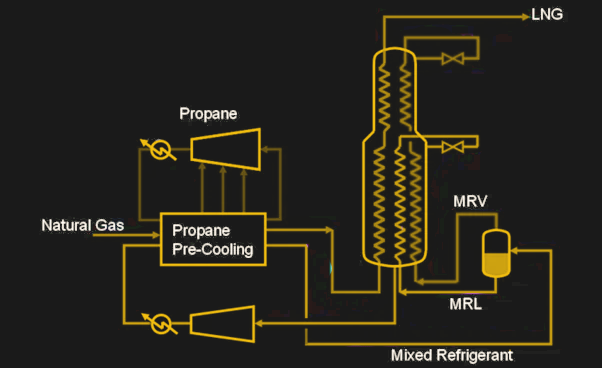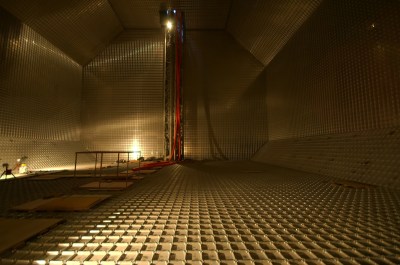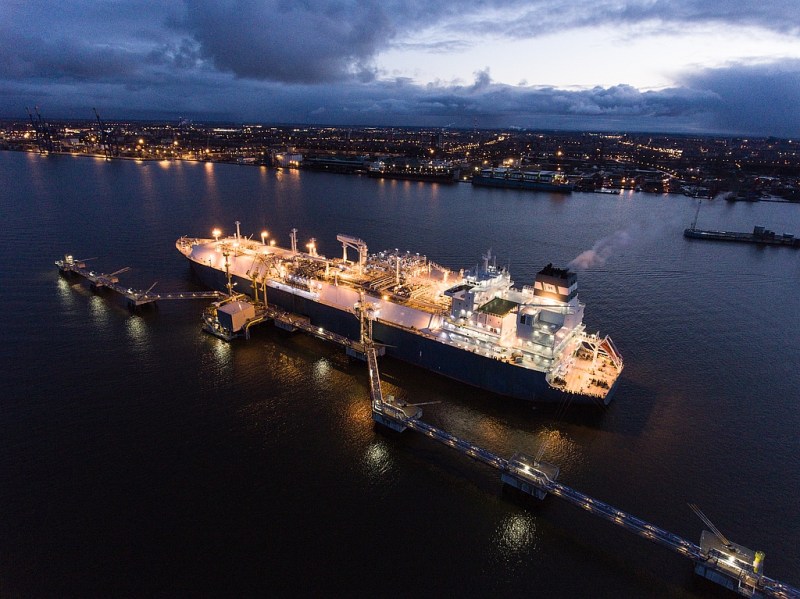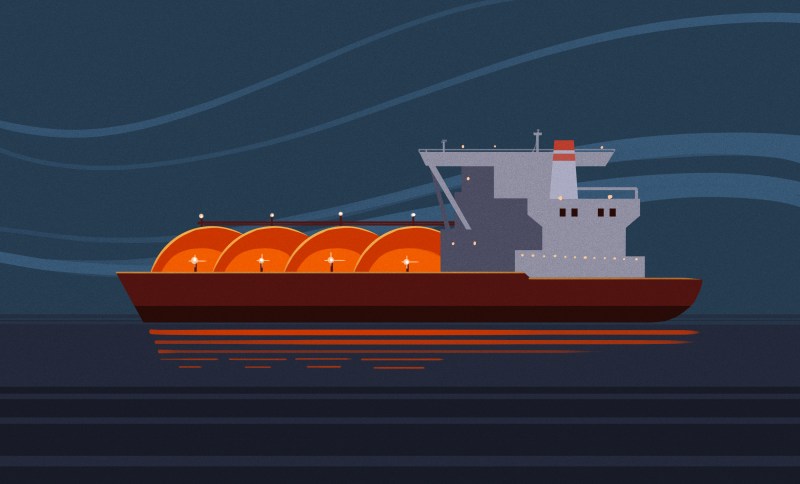The topic of energy has been top-of-mind for us since the first of our ancestors came down out of the trees looking for something to eat that wouldn’t eat them. But in a world where the neverending struggle for energy has been abstracted away to the flick of a finger on a light switch or thermostat, thanks to geopolitical forces many of us are now facing the wrath of winter with a completely different outlook on what it takes to stay warm.
The problem isn’t necessarily that we don’t have enough energy, it’s more that what we have is neither evenly distributed nor easily obtained. Moving energy from where it’s produced to where it’s needed is rarely a simple matter, and often poses significant and interesting engineering challenges. This is especially true for sources of energy that don’t pack a lot of punch into a small space, like natural gas. Getting it across a continent is challenging enough; getting it across an ocean is another thing altogether, and that’s where liquefied natural gas, or LNG, comes into the picture.
Liquefaction
Before we start looking at how LNG is made, it’s best to start by asking why we even need LNG in the first place. After all, we’ve got an incredibly complex, continent-spanning infrastructure of pipelines that’s optimized for the long-haul bulk transportation of natural gas. Why bother to go through all the effort and expense of liquefying natural gas?
In a word: oceans. Those vast networks of pipelines pretty much stop at the water’s edge, and while there certainly are some undersea natural gas pipelines, recent events have shown us just how vulnerable those can be. So shipping natural gas by sea has become a necessary means of moving energy from point A to point B. And to do that efficiently, you need to dramatically reduce its volume. Turning natural gas into a liquid does exactly that: it increases its density 600 times, making it feasible to ship in bulk.
The feedstock for liquefied natural gas is, of course, natural gas. We’ve already covered a fair amount about the process of harvesting and distributing natural gas, but briefly, natural gas is a mixture of hydrocarbons like methane and ethane produced from the decay of ancient biomass in geological formations. Along with liquid hydrocarbons and contaminants like nitrogen, carbon dioxide, sulfur-containing compounds, and water vapor, the gas accumulates in underground reservoirs that are tapped by drilling.
Raw natural gas is transported, under its natural pressure or with the help of enormous compressors, via pipelines to plants that clean the gas. Recovering sulfur and helium, both valuable chemical elements, from the raw gas is especially important, but it’s also important to scrub low-value contaminants like water and CO2 from the natural gas, since they can both cause freezing problems down the line. Water is removed by bubbling the raw natural gas through triethylene glycol (TEG), an extremely hygroscopic solution, while CO2 is removed using an amine scrubber, which exposes the acidic raw gas to nitrogen-containing amine solutions like diethylamine (DEA), which adsorbs the CO2. After further purification, which removes any remaining heavier hydrocarbons and contaminants like mercury, which will not behave when exposed to aluminum and stainless steel, the natural gas feedstock is about 85% to 90% methane (CH4), with the rest being a mix of ethane (C2H6), propane (C3H8), and butane (C4H10).
The clean, dry natural gas is then ready for liquefaction. Like most gases, natural gas will condense into a liquid when its temperature drops below its boiling point, which is -161.5°C for methane. So, to make LNG, an industrial-scale cryogenic process is required. Most LNG today is made with a process called C3MR, which is a dual-loop progressive cooling system. The “C3” refers to propane, a three-carbon compound used as the refrigerant in the pre-cooling loop. Each half of the cycle is essentially the same as found in any refrigerator, although vastly different in scale. In the precooling stage, liquid propane is passed through an expansion valve, which causes a phase change and a sudden drop in temperature. The cooled propane removes heat from the natural gas via a heat exchanger, the propane is compressed with a three-stage compressor, and the heat is removed via a condenser so the cycle can begin again.

After pre-cooling, the natural gas is at about -33°C — cold, but not cold enough. The cooled gas now enters the “MR,” or “mixed-refrigerant” loop, with a mix of propane, pentane, methane, and ethylene used. Again, the thermal cycle is familiar, but the scale is even more massive — the coil-type heat exchangers used in some MR loops can have thousands of kilometers of tubing coiled up inside them, with a heat exchange area of 40,000 square meters. There are also plate-fin heat exchangers, which have multiple layers of corrugated fins sandwiched between flat aluminum plates. Plate-fin heat exchangers are installed in insulation-filled enclosures called cold boxes. Both types of heat exchangers are usually deployed in parallel assemblies called trains to achieve massive throughput and redundancy.
After the MR loop, the natural gas has dropped to about -160°C and is now a colorless, odorless, non-toxic liquid. The energy input to get to this point has been considerable — something like 13 kilowatts to yield a single tonne of LNG. As of 2021, the global liquefaction capacity was over 450 million tonnes per year, with more capacity still under construction.
Storage and Transportation
But all of this production means nothing without somewhere to put all this LNG. The cryogenic nature of LNG presents certain engineering challenges. While not as cold as liquid nitrogen or oxygen, LNG can still cause steel embrittlement, which is why special alloys of stainless steel are used for LNG piping and tanks. Storage tanks, which are used to hold LNG temporarily between production and shipping, also have to be carefully engineered. These tanks are often built partially or even fully underground; while the subsoil provides insulation that reduces heat transfer into the LNG, the cold can freeze groundwater and cause frost heave underneath the tanks. Storage tanks also have to allow for some boil-off of the LNG, with the resulting natural gas either captured and sold off through regular distribution channels, or piped back to the beginning of the process and reliquefied.

Getting LNG from one place to another is the job of specialized LNG tankers, massive vessels that are purpose-built to safely and efficiently move as much LNG as possible. Although ship designs vary, most of the approximately 550 vessels in the LNG fleet use what’s known as “Moss tanks,” giant spheres that stick up above the deck. Most ships have either four or five of these heavily insulated tanks; while their spherical shape isn’t terribly efficient in terms of using all the volume of the ship’s hull, it does eliminate the danger of cargo sloshing. Newer “prismatic” LNG carriers are being designed, with cargo tanks that more completely fill the hull space. The tanks are lined with an insulated membrane made from either high-nickel stainless steel or the alloy invar, which reduces thermal expansion and contraction. The biggest tankers can hold over 250,000 cubic meters of LNG.
Due to the dangerous nature of their cargo, LNG tankers have to be built with safety in mind. No matter how good the tank insulation is, there will inevitably be some boil-off of the cargo while in transit. Many tankers tap this gas and use it as fuel. The ships also have extensive monitoring systems to detect leaks; unlike natural gas that’s piped to homes and businesses, LNG does not contain methylmercaptan odorant. So methane sensors are located in just about every space on an LNG tanker.
Regasification
Once a cargo of LNG arrives at its destination, it has to be turned back into a gas before being used. The regasification process is basically the opposite of liquefaction, with the LNG being gently heated to above the boiling point. Since the LNG is transported at just below its boiling point, it doesn’t take much of a temperature change to force the phase transition. But that doesn’t mean it’s a simple process.
Regasification can either occur in plants located adjacent to port facilities purpose-built to accommodate LNG tankers, or it can be done by floating storage and regasification units, or FSRUs. FSRUs look very similar to LNG tankers, and have a lot of the same equipment, including ether Moss-type spherical storage tanks or prismatic tanks. FSRUs are also equipped with a regasification plant, which takes the LNG from its storage tanks, passes it through heat exchangers, and pipes the boiled-off natural gas to shore via submerged pipelines. The advantage that FSRUs have versus onshore regasification plants is versatility — there’s no need to wait for favorable tides for an LNG tanker to dock, so offloading can occur whenever the ship arrives.

Whether onshore or floating, the heat for regasification is derived from a variety of sources. Many plants use vaporizers, which heat up the LNG by blowing ambient temperature air over heat exchangers with giant fans. Sometimes, seawater is used as the heat transfer medium, with ambient temperature water sprayed over the heat exchanger coils. Where ambient temperatures are lower, some regasifiers will use submerged combustion vaporizers (SCVs), which have burners submerged in large vats of water. Exhaust gas from the burners heats the water, which in turn heats the LNG as it passes through coils in the tank. SCVs are generally powered by natural gas that’s tapped off from the output.
Once the natural gas is back into its gaseous phase it’s ready to enter the local distribution system. Pipeline operators generally run their distribution systems at 30-80 bar (3,000-8,000 kPa), so the output of the regasifier plant has to match that spec. Rather than compressing the output gas from the regasifier, it turns out to be easier and more efficient to pressurize the LNG input using pumps. The pipeline operator will generally do quality control testing on a batch of LNG before releasing it to its customers, and will of course add in the required methylmercaptan odorant.
The LNG supply chain is pretty complex, but surprisingly energy efficient. Most of the energy goes into liquefaction and transport, with only a little energy needed to push the cryogenic liquid back into a gas. In terms of infrastructure, there’s definitely a lot of that at both ends of the supply chain. But in most cases, the LNG system is the most efficient way to transport chemical energy over vast distances.
[Featured images: Moss-type LNG tanker Arctic Princess. Source: JoachimKohlerBremen, CC BY-SA 4.0.]
















… something like 13 kilowatts to yield a single tonne of LNG….
Missing a unit. kilowatt-hours? tonne per day?
in Thermodynamic and heat transfer analysis of LNG energy recovery for power production
(A Franco and C Casarosa 2014 J. Phys.: Conf. Ser. 547 012012), they quote a value of 2.9 MJ/kg, or 800 kW-h/tonne. 33 kW-h/tonne/day.
Yeesh. I even screwed up the units. That would be 33 kW/t/d
Kilowatts per day is a tricky unit. You have to be very specific to point out your order of operations, or you will end up with Joules per second squared which is nonsense.
Assuming kilowatt-hours, it’s actually a very tiny amount. Just 46.8 MJ while methane has a heating value of 55 MJ/kg. This makes the cost to liquefy the natural gas less than 0.1% of the energy content. In other words, the process is more than 99.9% efficient.
or closer to 5%, if you believe the reference I quote above.
And given that liquefaction energy input is electrical, you’ll use at least twice that much input gas energy to produce the electricity, so to liquefy it takes a 10% tithe on the gas.
Maybe it’s the difference between what is thermodynamically necessary, and what is actually the state of art. Dan doesn’t cite sources for the information.
Is it really necessarily electrical or could you run the liqufaction compressors with a gas turbine? Like the pipeline compressors.
I toured a new LNG facility near Darwin, Australia. The guides didn’t explicitly tell us, but it looked and sounded like gas turbines.
“Many were increasingly of the opinion that they’d all made a big mistake in coming down from the trees in the first place. And some said that even the trees had been a bad move, and that no one should ever have left the oceans.” – Douglas Adams.
Hell, have you watched Hyperland recently? Definitely rough on production quality but Adams was eerily on the nose about algorithms…. er…. software agents.
If when liquified, LNG is at -160C, who cares if it is non-toxic? Toxicity would be low down on your list of priorities.
Even at room temperature, toxicity of methane is not high on my list of concerns with the stuff. A single kilogram of it loose in my house will reduce my house to splinters.
Actually methanol (natural gas) is super toxic and it makes you blind. If anything we should be investing in ethanol or LPG. Ethanol is safe to drink and LPG is used as fuel for cooking and for cars.
Methane != methanol. Methane is CH4, methanol is CH3OH. Methane is non toxic, methanol is quite toxic.
Methane is a component of natural gas. Methanol is not.
Methane (“natural gas”) CH4 != Methanol CH3OH
So two different compounds
You’re thinking of wood alcohol. I for one am very glad that people’s farts do not make you blind (though they may still be toxic)
Lol, amusing but NO! Methanol also known as “wood alcohol” is rather toxic, and not the same substance as methane or methamphetamine for that matter. And ethanol is not exactly safe to drink. Yes many people do consume it, and also suffer long-term effects from it as well. But the human body will always be happier and healthier without ethanol consumption.
Excellent article! You guys really churn out some great stuff across a wide variety of subjects.
“geopolitical forces” It’s ok you can say “extremely unpopular and pointless war.” Here’s a great solution to the “gas on a boat” problem, stop the proxy war and turn the pipelines back on. That way your citizens don’t have to go broke or die deaths of despair for “geopolitical forces”
Really isn’t a solution, the pipes have holes in ’em… And even if it was a possible solution I don’t think anybody much in Europe is even remotely close to thinking its a good idea to work with and trust Putin any time soon…
How convenient it is to forget the coup of 2014 and Nuland’s (f the EU) cookies.
the coup of 2014? you mean the one where Russia annexed Crimea, or the one in Kyiv? And which of those neccessitates the wholesale destruction and slaughter Russia is unleashing in Ukraine right now, 8 years later?
And the cookies? Really? There is a whole telefone intercept of her explicitly discussing political meddling in the 2014 goings-on (https://www.bbc.com/news/world-europe-26079957), and you go with the cookie-distribution like some foil-hat? What audience are you trawling for? How many people conveniently fell out of windows instead of standing in Putins way in the last 10 years? Would that he was only distributing cookies via some of Lavrovs underlings instead.
a skeleton of the convenient deaths, btw:
https://www.businessinsider.com/list-of-people-putin-is-suspected-of-assassinating-2016-3
https://en.wikipedia.org/wiki/2022_Russian_businessmen_mystery_deaths
https://eu.usatoday.com/story/news/world/2017/05/02/dozens-russian-deaths-cast-suspicion-vladimir-putin/100480734/
Former chancellor Angela Merkel spilled the beans in an interview few weeks back (and doubled down on the admission this past week) that the EU (actually, the US/UK/NATO/EU collectively) viewed the Minsk accord as just a ploy to buy time to train and better arm a Ukraine proxy army to eventually – and intentionally – go to war with the Russian Federation.
This was the plan from the get go when the US Obama admin used a coup to install a compliant puppet govt in the Ukraine (one heavily embroiled with the rampant NeoNazi influence groups of western Ukraine – these latter being responsible for the war crimes murdering of Russian POWs, as recently attested to by a US-based contractor group that has employees operating in the Ukraine to train and assist on weapons systems).
IOW, the collective West is 1000 percent responsible for the outbreak of conflict in the Ukraine – it was entirely premeditated, and hence why the West always ignored Ukraine’s non compliance to the Minsk accords.
(From Russian Federation perspective, the Ukraine was a strategic security threat every bit as dour as communist Cuba was to the US when the former Soviet Union sought to place nuclear missiles in Cuba and thereby gain a definitive first strike advantage. The West realizes this, of course, and intentionally ignored the concern – intending to goad the Russian Federation to react.)
Putin, the Russian Federation, never did a thing to any of the NATO/EU member nations and the Russian Federation was entirely satisfied with just doing business with them. It was their [the collective West, but especially the EU] own stupidity and folly that has brought about the predicament they’re now in. Paying 8 times more for natural gas as LNG vs the pipeline NG from Russia – resulting in the permanent gutting and de-industrialization of the German economy and those EU nations closely linked as out source partners.
While North America scoops up EU businesses that chose to situate to a locale of better circumstances.
The actual root cause and benefactor is completely obvious here.
As anti-education, anti-science, anti-technology and anti-progress as the far right dickheads usually are it still surprises and saddens me when I find people posting their BS propaganda on a geeky technical site like Hack a Day. I would like to think that people would be more intelligent than that here and would not want to live in a right wing dominated world where we surely would not have the freedom to “hack” on our own outside of a lucky few working in government sanctioned shops on government sanctioned projects.
Anyone that would abandon a people to live as second class citizens under autocratic Russian rule absolutely deserve that life for themselves. And if given their way sooner or later would get that to as Russia would certainly not stop with Ukraine if allowed that conquest.
please do two things:
1) share a link to the alleged ‘spilling of the beans’ by Merkel
b) contemplate on what could be gained by Russia after the initial assault on Kiev in February 2022 failed, specifically what could be gained by Russia that was worth all the hundred thousands of dead and the millions of displaced. Any geopolitical advantage (or from your perspective: aversion of loss of geopolitical advantage) was null and void at that point. You’ll have new NATO members along your border, you lost customers for your oil&gas, you uncovered the deplorable state of the Russian military, … what, apart from Putins political future is there to save in this war?
Here’s your link.
You had already found out that he original article with Merkel’s confession is taken down. That’s why you asked for it. So you could “prove” it doesn’t exist.
But here are the screenshots:
https://youtu.be/0-57KOwG9co
The USA has been at war ever since it’s formation except for some 12 years or so. The USA is the prototype bully scaring all the others in submission by using violence.
All of the recent Russian actions are provoked by the USA and cowards from the EU. Ukraine is an extremely corrupt country:
https://borgenproject.org/10-facts-about-corruption-in-ukraine/
To the USA: stick your democracy where the sun dont shine.
https://multipolarista.com/2022/02/01/dick-cheney-us-goal-break-up-russia/
If you can convince Vlad to withdraw from Ukraine, I for one, am all for it. If not, your comment is pretty much pointless.
You forgot the major point: PUTIN has to stop this war and leave Ukraine.
I wonder if you could run a heat engine to recapture some of the energy expended to liquefy the gas. To lazy to run the numbers. Raw carnot cycle calculator suggests 58% efficiency…
In other words, if you release some natural gas of your own, they’ll KNOW it was you.
It was the ships cat that did it.
A catastrophe in the making.
Smelly cat, smelly cat
What have they been feeding you?
Smelly cat, smelly cat
It’s not your fault
Well, now I know where all that cheap dry ice comes from now. They scoop it out of a several-tonne hopper here at the distributor (Air Liquide), into a bring-yer-own cooler. I asked the scooper dude where the stuff came from (me thinking “from thin air”, like argon): He said “The refinery”, meaning the oil & gas processing plants an hour from here. Now I see it’s a byproduct of cleaning up the fuel. ‘splains why they basically give it away. Cool.
That was a most rewarding read. The chemical and physical details are way beyond my expectations and are welcomed. Thanks for the work you put inti this article.
I don’t know about a spherical tank helping with the cargo sloshing. Could be, but more conventional approaches use baffles inside tanks for that.
Spherical tanks handle pressure better than other shapes. If they were smaller diameter – I would speculate that they could transport the LNG at a slightly higher temperature (needing to keep it at higher pressure), easing the demand on cooling systems.
But these are huge in diameter, which means they can’t hold very much pressure and definitely not enough to substantially change the boiling point. I think the primary reason for a spherical tank is to have the minimum surface area:volume ratio – to minimize unwanted heat transfer. If ‘good enough’ insulation is available – total heat transfer could be kept the same while more efficiently using the available cargo space. At least when comparing to a spherical tank with less effective insulation.
They might also:
– better handle stresses from thermal expansion, and maybe also the ship shifting direction
– mayyybe to give the crew a little bit more time to respond to a loss of cooling before the emergency pressure relief valves are pushed open.
I am also sure, that minimizing the surface area (heat transfer) is the main reason for the spherical form.
I wish the EU stood up and banned receiving LNG from the US.
But obviously the EU
motherf..leaders are too busy being groveling hypocrites.I wish the EU would ban people as retarded as you.
If you want to ban some person from the EU then you could rent a truck and Nicely explain him the error of his ways.
MANY in the public view “natural gas” as clean, non-fossil fuel alternative to “methane”, and which contributes nothing to climate change.
We’ve all seen the public confuse the two. Which means the industry’s strategy of greenwashing and confusion IS working.
(and that’s not surprising… it is rare for any media platform to explain they’re the SAME thin, or why the industry doesn’t like using the name “methane” for public-facing content..)
I’m curious as to why it needs an energy source to heat it.
If the liquid was simply moved into a larger container where it has less pressure wouldn’t it “suck” heat from the surounding environment and expand back into gas?
I suppose at some point the surounding air might become cold enough to slow the process but circulation would bring fresh warmer air to get the job done eventually. What’s the hurry?